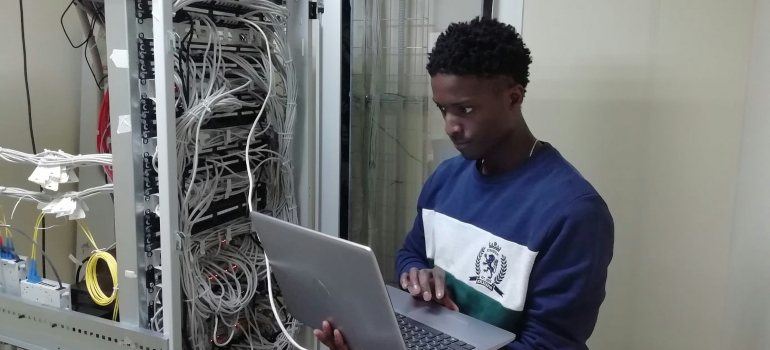Developing a Data Center Relocation Risk Management Plan
Get a QuoteRelocating a data center is far more complex than moving everyday items like furniture or electronics—it’s a high-stakes operation that requires precision, planning, and a solid risk management strategy. With vast amounts of critical data and specialized equipment involved, any hiccup can lead to costly disruptions. This is why having a detailed data center relocation risk management plan is essential. Without it, unexpected issues can lead to downtime, data loss, or hefty costs. Here’s how to identify key risks and the best ways to mitigate them, keeping your relocation smooth and successful.
Identifying Potential Risks in Data Center Relocation
The first step in creating a solid plan is to identify the specific risks involved. By understanding these potential challenges, you can better prepare to handle them. Here are some essential steps for a reliable risk management plan, crucial for mastering data center relocation:
- Downtime and Service Disruption: Imagine trying to get work done, but the internet goes out, or your tools stop working. That’s what downtime feels like for a company—only worse because it can get costly fast. Backup systems are crucial to keep things running if systems go down.
- Data Loss and Corruption: When moving equipment with tons of important data, there’s always a risk of data loss or damage. To mitigate this, it’s wise to make multiple data backups and use encryption to protect sensitive information during the move.
- Hardware Damage: The servers and storage devices in a data center are delicate, and if they’re not handled carefully, they could be damaged or broken. Specialized packing materials and secure transport methods are essential to keep your servers and storage devices safe.
- Security Risks: Moves can leave a data center exposed to various security threats. Someone could try to steal the equipment, or hackers might take advantage of the situation if systems go offline. A mix of physical security (like locked cases) and digital security measures can help.
- Vendor and Supply Chain Risks: Reliability is crucial when working with external vendors. Choose partners with a solid track record, and always have a contingency plan in case of delays or other issues.

Developing a Data Center Relocation Risk Management Plan
Once you know the risks, it’s time to figure out how to handle them. One of the best ways to prepare is with contingency planning. Preparing for things to go wrong can make the whole move much easier. This might mean setting up a temporary workspace, keeping spare equipment on hand, or ensuring a backup plan for data access.
Another key step is ensuring everyone involved in the move stays on the same page. A clear communication plan helps keep everyone—the IT team, vendors, or clients—in the loop. That way, everyone knows the schedule, the potential risks, and what to do if something goes wrong.
Setting up backup systems and creating copies of important data is also smart. If unexpected issues arise, such as damaged equipment, you can rely on backup data and extra equipment to keep operations running while you resolve the issue.
Testing is essential, too. Test equipment and systems before and after the move to ensure everything is operational. Catching issues early can be resolved immediately, allowing for a smoother transition to your new location.
A Closer Look at Contingency Planning
In any effective risk management plan, you should prepare for the unexpected. Power outages, equipment failures, and delays are always possibilities, so crisis response strategies are essential. For example, if a server goes down, having a replacement ready will reduce downtime. If a power outage occurs, a generator can keep essential systems running. Thinking through these potential problems in advance can help you respond quickly and effectively.
Consider creating a recovery timeline as well. This timeline should act as a roadmap to guide your team through the steps necessary to get systems up and running again. This way, everyone knows what to do and how fast to act if something goes wrong.
Partnering with a provider like Interstate Technology Logistics, that is experienced in data center relocations, can also significantly enhance your contingency planning. A skilled team understands the everyday challenges, knows how to prepare backup solutions, and can ensure your equipment and data remain secure throughout the move.

Risk Assessment Tools and Metrics
Risk assessment tools and key performance indicators (KPIs) can make a big difference in managing your data center relocation. Risk analysis tools help identify potential infrastructure issues and rank the biggest threats so you can focus on what matters most.
Tracking KPIs, like downtime duration, data integrity, and equipment condition, acts as a progress scorecard. Monitoring these metrics throughout the move allows you to adjust strategies as needed, ensuring everything stays on track.
Reviewing the Move After Completion
After the data center move, it’s important to review how it went. Reviewing what worked and what didn’t can provide valuable insights for future moves. Any issues that arose can be analyzed and used to improve your risk management plan, helping make the next move even more efficient.
Continue monitoring equipment and security in the new location as well. Regular checks and security audits help ensure everything remains fully operational.

Securing Success with Your Data Center Move
Relocating a data center is a major undertaking, and with a well-structured data center relocation risk management plan, you can tackle it confidently. Identifying risks upfront, developing solid strategies, and monitoring every step during and after the move all contribute to an easier move. If you’re facing a data center move, having a clear plan that protects your data and minimizes disruptions is essential. When it’s time to choose a data migration company, go with one that understands the unique challenges of data center relocation. The right partner will help keep your data secure and your operations running smoothly, setting you up for success in your new location.
